- About us»
- Net income calculator»
- Population aging»
-
- Least developed regions»
-
- Average wage
- Material need benefits
- Meal allowance
- Counties of Slovakia
- Inflation
- Living and Subsistence Minimum
- Unemployment of Czechia and Slovakia
- NACE Classification
-
- Life expectancy
- Gender differences
- Youth unemployment and NEET
- Minimum wage in EU
- Unemployment rates of different age groups
- Share of salaries on GDP
- Unemployment rate
- Employment rate
- Percentage of employees ususally working at nights
- Long term unemployment
- NEET
-
- Bratislava and surroundings
- Kopanice
- Danube river
- lower Vah river
- middle Vár river
- upper Nitra river
- lower Nitra river
- Mining cities
- Kysuce a Orava
- upper Vah river - Liptov
- Spiš cities
- upper Hron river
- Juhoslovenská kotlina
- Košice fold and Torysa river
- upper Zemplín
- lower Zemplín
- EU regions
- NUTS3 regions of Slovakia
- LAU1 dataset
-
- Projects and activities
- Inclusive growth»
- Good work
- Project SKRS
- Social system – reality and vision
-
- Education of unemployed
- Young unemployed not taking part in education
- Proposal to change the system of education funding
- Library
- News»
- Contact
Limousin – FRI2
EU regions: France > Nouvelle-Aquitaine > Limousin
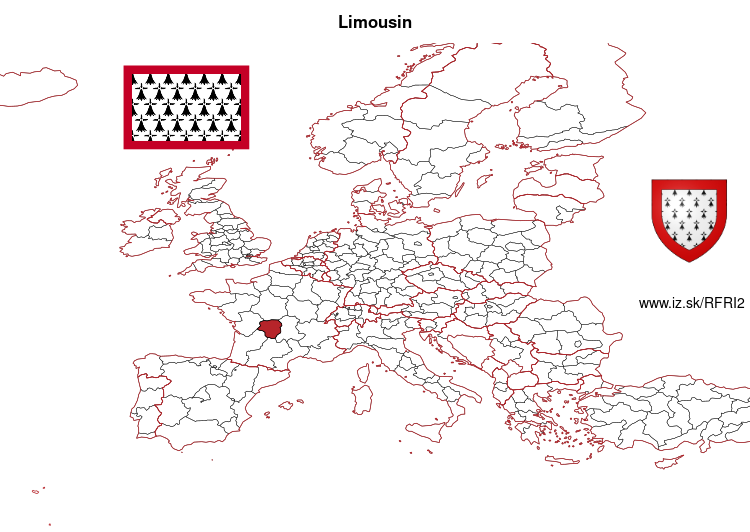
| Indicator | Period | Value |
|---|---|---|
| Life long learning | ||
| life long learning participation | 2024 | 14.5 |
| Part time jobs and flexible employment | ||
| percentage of part time workers | 2024 | 17.9 |
| percentage of part time workers, men | 2024 | 11.29 |
| percentage of part time workers, women | 2024 | 25 |
| Gender differences | ||
| gender gap in employment rate | 2024 | 89.68 |
| gender gap in unemployment rate | 2024 | 100 |
| Graduates and young people | ||
| unemployment rate of youth with elementary education | 2017 | 31.5 |
| NEET | 2024 | 11.5 |
| Gross domestic product | ||
| GDP per capita in PPS of EU average | 2023 | 73 |
| Employment | ||
| employment rate | 2024 | 70.6 |
Limousin slovensky: FRI2
Subregions: Corrèze, Creuse, Haute-Vienne
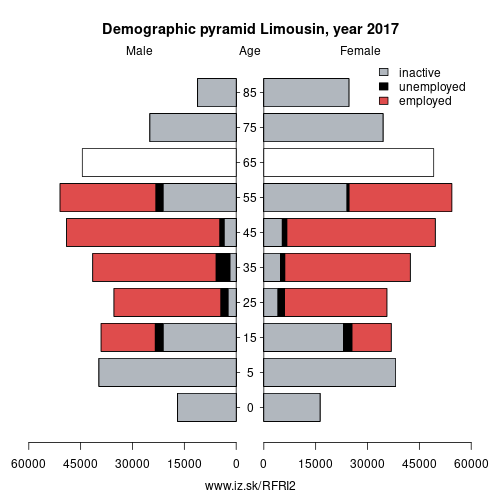
Unemployment
| Indicator | Period | Value |
|---|---|---|
| Unemployment | ||
| unemployment rate | 2024 | 5.5 |
| youth unemployment rate | 2023 | 15 |
| Long term unemployment | ||
| long term unemployment | 2021 | 1.7 |
| share of long term unemployed | 2021 | 27.8 |
Demographics
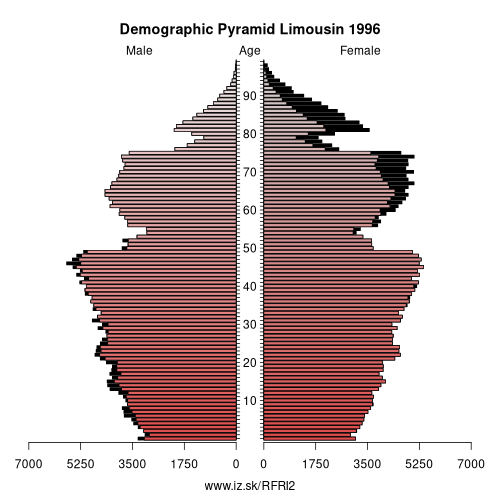
| Indicator | Period | Value |
|---|---|---|
| Demographics | ||
| number of inhabitants | 2024 | 726 151 |
| population density | 2023 | 42.8 |
| old-age dependency ratio | 2024 | 48.9 |
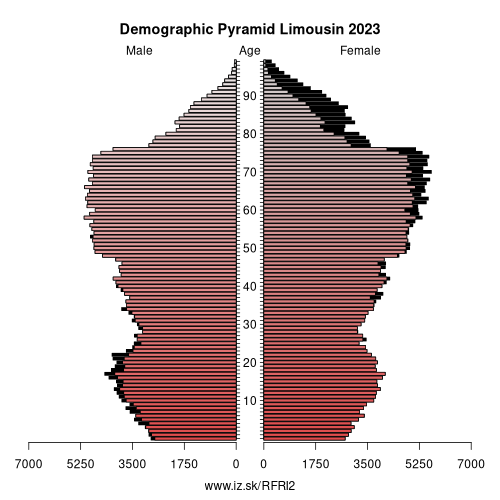
Employment by sectors, Limousin
| NACE r2 | % | NACE r2 | % | ||
|---|---|---|---|---|---|
| A | 15.3 | 5% | B-E | 39.3 | 14% |
| F | 20.4 | 7% | G-I | 54.2 | 19% |
| K | 6.7 | 2% | M_N | 23.1 | 8% |
| NRP | 5.9 | 2% | O-Q | 103.3 | 36% |
| R-U | 12.4 | 4% | TOTAL | 287.9 | 100% |
Data for the period year 2024. Source of the data is Eurostat, table [lfst_r_lfe2en2].
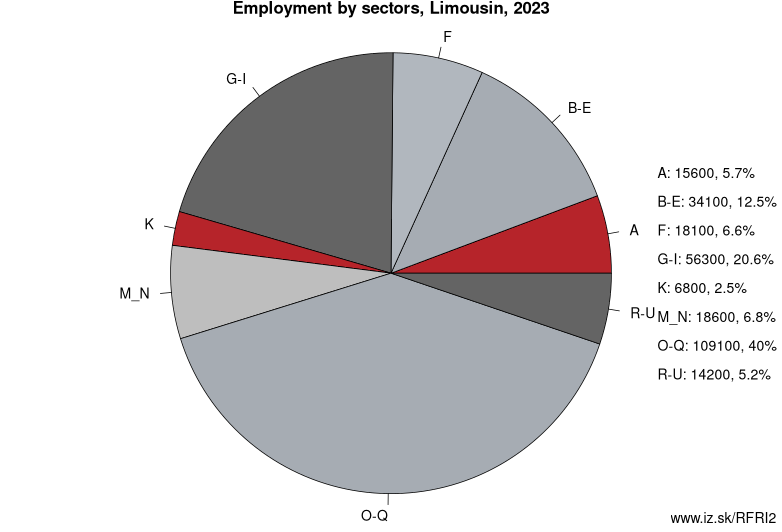
From Wikipedia : Limousin (French: [limuzɛ̃] (listen); Occitan: Lemosin [lemuˈzi]) is a former administrative region of southwest-central France. On 1 January 2016, it became part of the new administrative region of Nouvelle-Aquitaine. It comprised three departments: Corrèze, Creuse, and Haute-Vienne.
Situated mostly in the west side of south-central French Massif Central, Limousin had (in 2010) 742,770 inhabitants spread out on nearly 17,000 km2 (6,600 square miles), making it the least populated region of metropolitan France.
Forming part of the southwest of the country, Limousin is bordered by the regions of Centre-Val de Loire to the north, Auvergne to the east, Midi-Pyrénées to the south, Aquitaine to the southwest, and Poitou-Charentes to the west. Limousin is also part of the larger historical Occitania region.
Formation
The modern region of Limousin is essentially composed of two historical French provinces:
- Limousin: the department of Corrèze in its entirety and the central and southeastern part of Haute-Vienne. The entire old province of Limousin is contained within the modern Limousin.
- Marche: most of the department of Creuse and the north of Haute-Vienne. The old province of Marche is almost entirely contained within the modern region of Limousin, with only a small part of Marche now belonging to the region of Centre.
- Angoumois: extreme south-west of Haute-Vienne
- Poitou: extreme west of Haute-Vienne
- Auvergne: extreme east of Creuse
- Berry: extreme north of Creuse
Other: Nouvelle-Aquitaine, Poitou-Charentes, Aquitaine, Limousin
Neighbours: Auvergne, Centre-Val de Loire, Midi-Pyrénées, Poitou-Charentes, Aquitaine
Subregions: Corrèze, Creuse, Haute-Vienne
Suggested citation: Michal Páleník: Europe and its regions in numbers - Limousin – FRI2, IZ Bratislava, retrieved from: https://www.iz.sk/PFRI2, ISBN: 978-80-970204-9-1, DOI:10.5281/zenodo.10200164
Similar articles
Navigation:
- Short news
- Local Administrative Units data of Visegrad countries open data
- Projects and activities
- European regions
- Random region: Hungary, Central Hungary, Budapest

 Share
Share Facebook
Facebook Twitter
Twitter News
News